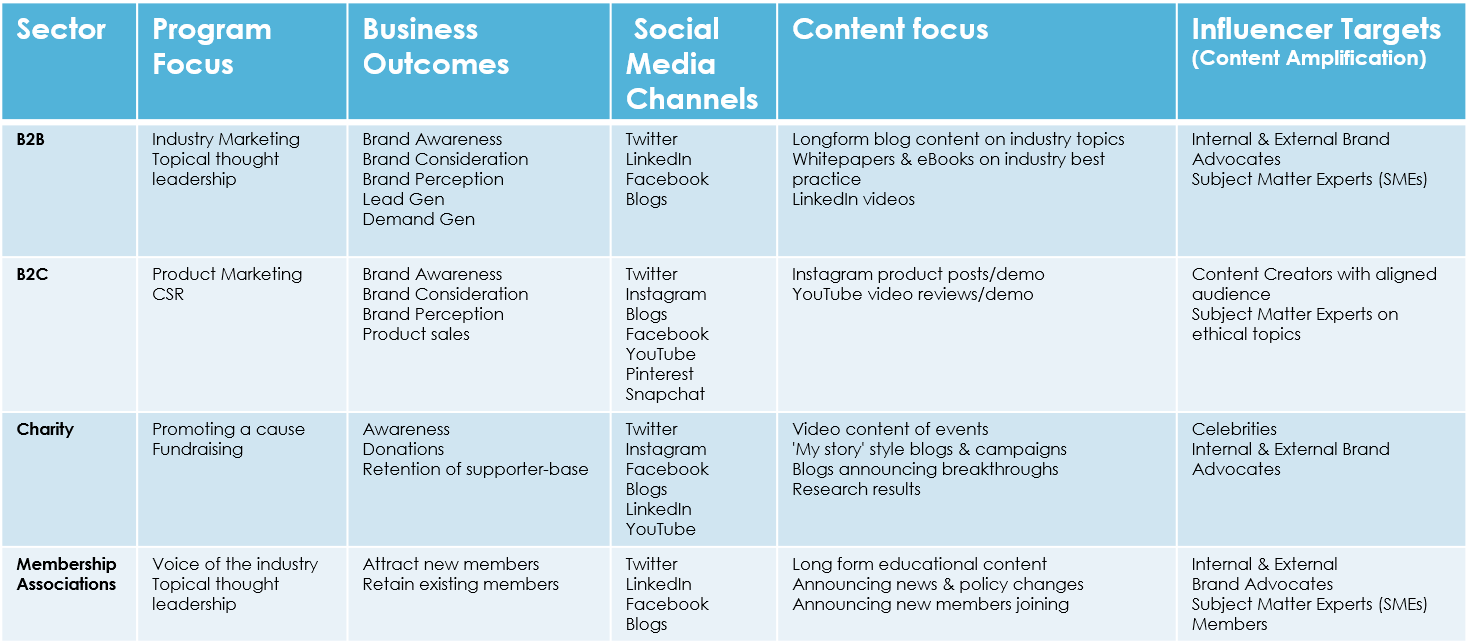There’s no denying that the attributes of a B2B buyer differ greatly from a B2C consumer’s. B2B buyer journeys are much longer and more complex with a higher average purchase price, compared to buyer journeys in B2C which tend to be much shorter, more impulsive and lower value purchases.
Because of this, marketers in B2B and B2C have very different objectives, strategies and tactics to reach their target audience and drive action. It’s also worth throwing charities and membership associations into this mix, that are also, inherently different.
But to get to the question at hand, is employee advocacy just for B2B? If we look at this strictly in the context of employee advocacy, there are perhaps more similarities than we’d expect when comparing sectors, so the short answer is no. When it comes down to the brand motivations behind employee advocacy, they are largely the same. The concept of putting employees in the limelight and humanizing the brand to build trust and transparency is equally necessary and applicable in the context of B2C, B2B, Charities and Membership Associations. Regardless of whether the customer is a buyer or a consumer, they are increasingly trusting brands less and people more.
Something that marketers must bear in mind when creating their strategy is that the major difference between B2B and B2C is that in B2C, consumers want to spend money on things they do not need, whereas B2B buyers do not want to spend money on things they do need. This creates a longer and more complex buyer journey involving multiple stakeholders in the decision-making process. Charity customer buyer journeys are far more emotive and buyer journeys for membership associations are in a lot of cases mandatory or the industry standard.
Consequently, this contributes to a very different culture of content creation between sectors. FMCG brands such as McDonalds, Levi’s and Chanel are more likely to focus on creating content around being a great brand to work for in terms of environment, great products and social purpose whereas IBM, Schneider Electric, Shell and HSBC will focus on more thought leadership content talking about the issues, challenges and innovations facing consumers in the marketplace. Charities focus on creating content that raises awareness of the cause whereas membership associations want to be the leading voice of the industry. Each sector will also have different preferences over social media channels, and different types of influencer engagement targets.
Read on to learn a top-line summary of how each sector differs in their: program focus, business outcomes, social media channels, content focus and influencer targets.

Download Employee Advocacy 2.0
1. Employee Advocacy in B2B
Program Focus
The focus for influencer marketing and employee advocacy programs in B2B tends to be more focused on industry marketing and topical thought leadership rather than brand and product marketing. B2B marketers have the means to know who their buyers are and what roles they’re in, so have the ability to be very targeted in their outbound marketing and content marketing strategies.
The approach tends to be identifying the industry issues that their customer personas will be facing and becoming thought leaders in that space. Brands can then leverage their internal and external influencers to amplify their thought leadership content with their audiences, as well as making contributions and creating their own content. This intrinsically works to help promote the brand and its products & expertise as a solution to the industry problem that their target customers are facing.
Business Outcomes
With the above said, the overall business outcomes that employee advocacy and influencer marketing works towards are increasing brand awareness with their target audience through their employees’ audiences, driving brand consideration over their competitors, shaping their brand perception to be leaders in their space, and driving demand and leads for their sales teams.
Social Media Channels
When it comes to knowing which social media channels brands should focus on, it is as simple as ‘be where your customers are’, in the same way that you wouldn’t go fishing in an empty pond. With this said, B2B buyers have a presence, are engaging with content and doing their research on platforms such as LinkedIn, Twitter, Facebook and blogs too (both prospective suppliers’ and influencers’ blogs). These platforms allow for marketers to target their content to the right organisations and job titles. Employees can help drive this process by creating and sharing their own content on these channels and building relationships both direct with prospects (through their employees) and through the influencers that influence their prospects, on these channels.
Content Focus
Higher value, long form content is a big focus for B2B. Creating industry standard, best practice guides that will help their prospects and clients, while also acting as a lead capture. This kind of content is also a great engagement opportunity for employees to build relationships with influencers, so that they can contribute insights and quotes to the piece.
Video content, which is often only regarded as being important for B2C, is also really beginning to make its way onto the B2B scene. Employees are creating more video content on LinkedIn talking about industry topics as thought leaders in their own right. Video content is extremely engaging and great for sparking debate and conversation, particularly if industry influencers are being tagged in the content. What’s also great about video, is that the content immediately seems more authentic as you can actually see the employee, so you know it’s their own message and not the brand’s.
Influencer targets for content amplification
The main theme behind our Employee Advocacy 2.0 guide is connecting your internal influencer community (your employees) with your external influencer community (the more traditional ‘influencer’), to amplify content. This content can be branded content, content that your employees are writing themselves and also content created with influencer contributions. The influencer types that your employees should engage with varies depending on the content at hand and which sector you’re operating in. As we’ve already said, content in B2B is more focused on solving industry issues and creating topical thought leadership, so engaging with subject matter experts that are leading the conversations and movements on the topic that is relevant to your brand, then connecting your internal experts with them is most appropriate and will yield the most results.
2. Employee Advocacy in B2C
Program Focus
Unlike B2B, B2C have an idea of the kinds of demographics they’re targeting their product to, but without the level of detail of B2B (i.e. they do not know job roles). Influencer marketing and employee advocacy programs tend to be less targeted and more focused on product marketing and raising awareness of what CSR initiatives they’re running.
Business Outcomes
Business outcomes for B2C are also around driving brand awareness and consideration, as well as shaping brand perception as a great, ethical brand to work for and buy from. Where they differ from B2B is that the shorter buyer journey and lower value purchase point creates a laser focus on increasing product sales and revenue from their campaigns. This is partly due to action in clicks and buys being much easier to measure.
Social Media Channels
A more creative and product focused content strategy means that platforms such as Instagram, Twitter, Blogs, Facebook, YouTube, Pinterest and Snapchat are a focus for B2C brands. These are also the platforms that consumers are engaging on at their leisure. These social channels also have the ability to delve down into profile demographics so that brands can target the right kind of audience.
However, when it comes to raising awareness of their CSR initiatives, the focus will be more on building partnerships and creating blog posts that are then shared by employees on their social media channels.
Content Focus
Given that the focus in B2C is more around the brand and their products, content tends to be promotional, yet creative and visual, showing and demonstrating products being used. This is often picture and video content on YouTube and Instagram such as unboxing and tutorial videos. Facebook and Twitter are often supporting channels to promote and create engagement on content hosted on Instagram and YouTube. It is on these channels that employees can add their own commentary and share the content with their audience to promote content and engage with relevant influencers to both amplify the content and build their own profile.
Influencer targets for content amplification
On the product marketing front, the focus tends to be on influencers whose content style is well matched with the brand’s content, and whose target audience is also very aligned and engaged. When it comes to amplifying content on ethical issues and CSR, then the focus should be on identifying and engaging with influencers that are subject matter experts in those areas. Employees that have expertise and/or interests in relevant areas can engage and build relationships with relevant influencers.
3. Employee Advocacy in Charities
Program Focus
Charities differ greatly from other sectors in that their target audience is in theory anyone that believes in the cause. It’s a far more emotive customer journey where money exchange is voluntary and down to the donor. Charities are also different in that there isn’t an inherent distrust towards charities like there is towards brands, due to the overall goal being to maximise fundraising rather than revenue. With this said, their influencer marketing and employee advocacy program focus is promoting and raising awareness of the cause and increasing fundraising.
Business Outcomes
Similarly to B2B and B2C, charities want to increase the awareness of both the charity and the cause that they’re supporting/aiding through their direct employees and volunteers. The aim is to raise awareness and in turn raise donations within their employees’ networks from new donors, as well as retaining donors from their existing supporter-base.
Social Media Channels
As outlined in program focus, charity targets can in theory be anyone, so all social media channels can be effective for employee advocacy and influencer marketing programs. However, there are certain charities that certain demographics will have an affinity for. For example, a charity whose focus is on women’s rights, will understandably resonate with a female audience. So, platforms that enable you to most effectively reach this demographic, such as Instagram, may be more appropriate in this case. Which channels are most effective depends on the charity and the campaign at hand. With this said, there are opportunities for charities to engage on Twitter, Instagram, Facebook, Blogs, LinkedIn and YouTube.
Content Focus
Again, content focus can differ greatly depending on the charity, campaign and who they’re trying to reach. Video content also has its place in the charity sector to increase awareness and coverage of fundraising events and campaigns. Content that shares benefactors’ ‘my story’ style content can also be extremely effective and evoke the emotional element. Social media campaigns that start out with the intention of going viral to increase awareness of the cause are being seen more. For example, the charity Jo’s Trust encouraging women to share pictures of themselves captioned #SmearForSmear, on Instagram, Twitter and Facebook with smudged lipstick to raise awareness of cervical cancer and to encourage women to attend their smear tests.
Influencer Targets for content amplification
Anyone that supports the cause can be an advocate, and we all tend to have natural affinities for particular charities based on our demographic and whether we’ve been directly or indirectly affected in some way during out lifetimes. Celebrities and higher profile influencers are much easier to engage organically for charities for this exact reason. Celebrities with large social media audiences can be great for brand awareness, and content creators such as YouTubers are great for creativity when it comes to creating content that can become viral (for example, inviting YouTubers along to events to film the event to share with the audience).
Internal employees and volunteers have a great opportunity to share the work that they’re doing with their audiences and engage with relevant influencers to amplify this exposure.
4. Employee Advocacy in Membership Associations
Program Focus
Membership associations are very similar to B2B organisations in that their focus is very much on industry issues and topical thought leadership. The difference however is that their aim is to be the leading voice of the industry for their members. What’s particularly interesting about membership associations too is that they have great scope to scale. Membership associations can be quite small in terms of number of employees, but astronomical in their membership, particularly if it’s the industry standard and norm to join (think of the likes of financial bodies such as ACA, ACCA and CIMA).
Business Outcomes
Membership associations are no different in wanting to achieve brand awareness but the two business outcomes that are front of mind is attracting new members and retaining existing members, as this is how they generate their revenue.
Social Media Channels
Again, social media channel focus is fairly similar to B2B. The kinds of people that join membership associations are professionals that are likely to have a presence on social media channels such as LinkedIn, Twitter and Facebook. Producing content on blogs is also a focus.
Content Focus
High value long form content that is relevant to their members’ (and target members’) roles, to aid them in effectively doing their job according to best practice. Topical thought leadership content on industry wide topics to promote themselves as the voice of the industry to attract new members. Also writing press releases announcing news, policy changes and new members joining the organisation.
Influencer targets for content amplification
In regards to topical thought leadership content, subject matter experts are great to engage to collaborate on content, contribute quotes and share the content with their audience. When it comes to press releases on industry news and policy changes, relevant politicians and academics are also great for your employees to engage to add commentary.
The scope for brand advocates goes beyond industry influencers and employees here, as every individual member is a potential brand advocate. Connecting internal employees, members and influencers together, and encouraging each to contribute and collaborate on content will drive brand awareness and amplify content.
What have the experts got to say?

“Both consumer and B2B brands must build employee programs grounded in trust and transparency.”
Michael Brito, EVP at Zeno Group

“B2B and B2C are very similar and the objective is the same – increase reach and connect at a more human level with buyers. However, the content might be slightly different. In B2B it is more thought leadership and productivity content that will engage audiences. In B2C it might be more related to CSR type activity or product related.”
Sarah Goodall, Founder of Tribal Impact

“While the lines are blurring between sectors, one thing they’ve got in common is that relationship building on-line takes time. One key differentiator is that in B2B brands have the opportunity to position employees not only to represent their expertise but also to express brand/product value in the exchange through brand evangelism.”
Susan Emerick, Senior Manager Global Marketing & Advocacy at IBM

“There are more similarities than differences between B2B and B2C when it comes to employee advocacy. People still buy from people and in both cases, it’s about empowering the people, telling the people’s story, having the people build that trust. And it doesn’t matter if It’s B2C or B2B in that case.”
Brian Fanzo, Founder of iSocialFanz

” Regardless of what sector you’re in, the key thing is that the advocates should be sharing content that is natural and authentic for them to share, and that will be relevant to the end audience. Use the tech to help you achieve this.”
Caroline Jory, Engagement Director at Qubist

“As the lines blur between different sectors, authenticity has become the new goal for every brand. The future of business is in your employees’ voice. It can’t be fake, but it can be taught. This requires a cultural investment beginning in the C-Suite and radiating outward by establishing a strong set mission, vision, and values for your brand.”
Cheryl Burgess, CEO at Blue Focus Marketing

“As the lines blur between B2B and B2C brands, authenticity has become the new goal for every brand. The future of business is in your employees’ voice. It can’t be fake, but it can be taught. This requires a cultural investment beginning in the C-Suite and radiating outward by establishing a strong set mission, vision, and values for your brand.”
Eric Fuessel, Senior Account Executive at EveryoneSocial

“The biggest difference between B2B and B2C is social selling. Social selling is hard to do if you don’t know who your consumers are. For example you know a brand that is selling a B2B software to a specific industry can easily find their buyers on LinkedIn; a brand that sells widgets to the consumer market will find it much more difficult to find people who like a specific product in advanced search.”
Melonie Dodaro, CEO at Top Dog Social Media

“They are both very similar in the need to attract talent. We want to join a brand that has happy, engaged employees. The biggest difference come down to the buyer journey. B2C brands may not have the same information needs in their purchase decision. But employee advocacy can still have an impact in B2C. We may be more likely to buy from brands who seem to treat their employees well as evidence by their external passion.”
Michael Brenner, CEO at Marketing Insider Group

“B2B is really going to be focused more on working together with your sales programs, whereas B2C is probably going to be a lot more top of the funnel and because there’s just more influencer marketing in B2C by people I think that where B2B is going to be very content-centric, B2C. I think is going to be more focused on that brand awareness of leveraging influencer content.”
Neal Schaffer, CEO at PDCA Social

“The similarity between B2C and B2B employee advocacy is that you are working with colleagues to help them understand the best way to talk about their brand online – it’s not really different in that aspect”
Sonia Rosua-Clyne, Global Social Media at Sage

“In B2B there is a much deeper requirement to integrate employee advocacy, social selling and influencer marketing tactics as employees need to demonstrate expertise in their industry to win and retain clients.”
Tim Williams, CEO at Onlaytica

Download Employee Advocacy 2.0
TAGS
Employee Advocacy 2.0
Leveraging influence to drive a connected organisation and employee-led buyer journey
Download this free report to learn how to integrate Influencer Marketing, Employee Advocacy and Social Selling into one advocacy program.

